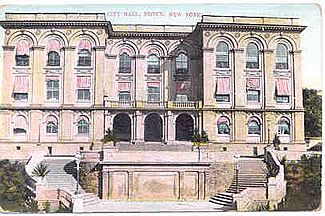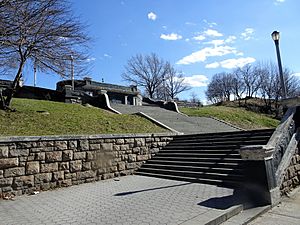Bronx Borough Hall facts for kids
Quick facts for kids Bronx Borough Hall |
|
|---|---|
 |
|
| Former names | The Bronx Municipal Building; Old Bronx Borough Hall |
| General information | |
| Type | Municipal Building |
| Architectural style | Renaissance |
| Location | Third Avenue & Tremont Avenue, The Bronx, New York |
| Coordinates | 40°50′46″N 73°53′44″W / 40.845975°N 73.895506°W |
| Completed | 1897 |
| Demolished | 1969 |
| Design and construction | |
| Architect | George B. Post |
| Designations | New York City Landmark (1965–1966) |
The Bronx Municipal Building was once the main office for the Bronx Borough President and other important local leaders. It was built in 1897 and was later known as Bronx Borough Hall. Eventually, people called it the Old Bronx Borough Hall before it was torn down in 1969. This important building was located in the Tremont neighborhood of the Bronx, New York City.
Many people thought it was a great example of architecture for its time. It sat on a rocky hill in what is now Tremont Park. From its high spot, you could see amazing views from far away. It was also a central place where important city business happened. The New York City Subway's IRT Third Avenue Line, which was the first elevated train in the Bronx, had a stop right in front of the building. This made it easy for people to get there.
Contents
How Was the Building Constructed?
The Bronx Municipal Building was designed by George B. Post (1837–1913). He was a very famous architect in New York City during that time. The building had three stories and faced west. It looked very artistic, with a Renaissance style. It was built with light yellow bricks and brown terra-cotta decorations.
George B. Post also designed other famous buildings. These include the main building of the New York Stock Exchange in Manhattan. Another architect, Russell Sturgis, even praised the Bronx building in 1896. He called it a "common sense building with pleasant architectural results."
Why Was a New Building Needed?
In 1874, the western part of the Bronx became part of New York City. About 40,000 people lived there then. The area grew very quickly, and by 1890, nearly 90,000 people called it home. City officials realized they needed a central place for government offices.
In 1891, the first official for the whole district was elected. More city agencies started to form, and they all needed office space. By 1895, the eastern part of the Bronx also joined New York City. With these new areas and many immigrants moving in, the Bronx population grew to about 200,000 people.
In 1895, Commissioner Louis F. Haffen led a successful effort to get a new building. The Bronx Municipal Building was finished in 1897. In 1898, it was renamed Bronx Borough Hall. This happened when other parts of New York City also joined together. Louis F. Haffen became the first Bronx Borough President and started his job in an office on the second floor that same year.
Why Did They Want a New Building?
In 1899, a grand staircase was added. It went down the steep hill to Third Avenue. This staircase might have been designed by George B. Post or by Louis Risse, the chief engineer of the Bronx. Later, after World War I, a beautiful garden called Victory Park was created near Borough Hall. It had paths and a large fountain to celebrate the Allied victory.
Even though the building looked nice and was built with a lot of effort, city leaders started to have doubts. They thought it was too small and couldn't handle the needs of the growing borough. In 1909, Louis Haffen, who was the Borough President, said the building he once supported was "entirely inadequate." He felt it was "impossible to enlarge or adapt" for the borough's needs.
By 1928, the fifth Borough President, Henry Bruckner, was pushing for a brand new Borough Hall. The Bronx Board of Trade even suggested building the new hall next to the old one, where Victory Garden was. They wanted to tear down the original building because they saw it as "a non-fireproof building entirely in-adequate and out-of-keeping with the size and importance of our Borough."
What Happened to the Old Building?
By 1930, just 30 years after it joined the city, the Bronx population had grown to more than 1.25 million people! Because of this huge growth, and during the Great Depression, the city built the Bronx County Courthouse between 1931 and 1934. This new, nine-story building was on the Grand Concourse.
By 1934, most of the borough's offices and government services moved from Borough Hall to this new courthouse. By 1964, only the Marriage License Bureau was left in the old building. The rest of the space was used for veterans and community programs. As years passed, the Bronx Borough Hall became known as the Old Bronx Borough Hall. The park area around it was called Old Borough Hall Park.
During the mid-1900s, the new Cross Bronx Expressway was built. Part of this highway, constructed in 1960, went through Crotona Park. It separated the northern part of the park, where Borough Hall stood, from the main park. This made the northern section even more separate. Old Borough Hall Park was then redesigned to include a baseball field and other sports areas. This was partly to make up for the parkland lost to the highway.
Why Was It Torn Down?
Soon, reports came out that there was a plan to tear down the Old Bronx Borough Hall. The Parks Commissioner, Newbold Morris, supported this idea. He wanted more park space, possibly to replace what was lost to the Cross Bronx Expressway. Also, the East Tremont Neighborhood Association wanted to either turn the building into a recreation center or replace it with a new community center. Both Morris and the association claimed the building was unsafe.
However, members of the Bronx County Historical Society, like Theodore Kazimiroff and Lloyd Ultan, wanted to save the building. They were all Bronx residents and had the full support of the Bronx Borough President, Joseph F. Periconi.
Becoming a Landmark (Briefly)
On September 21, 1965, the New York City Landmarks Preservation Commission held a public meeting. They discussed making the Old Bronx Borough Hall a landmark. Eight people, including the Borough Historian, spoke in favor of protecting the building. Only one person from the Parks Department was against it. The East Tremont Neighborhood Association wrote to the Commission, asking for the building to be torn down for a new recreation center. Other local groups agreed with them.
However, Borough President Periconi wrote to the Commission, saying he strongly supported making the building a historical landmark. With all the historical facts, the Landmarks Preservation Commission called the borough hall "a good example of public building" because of its beautiful design.
In October 1965, the Landmarks Preservation Commission officially made the building its 23rd landmark in New York City. Old Bronx Borough Hall became the very first Bronx landmark! But the law gave the New York City Board of Estimate 90 days to change or stop any landmark decision.
In December, Commissioner Newbold Morris again wrote to the board. He called the building "rundown, unsightly" and said it had "no architectural importance." Borough President Periconi had strongly supported the landmark status during his time in office. But in January 1966, a new Borough President, Herman Badillo, took over. On January 27, 1966, the very last day for review, the Board of Estimate listened to Badillo's view and voted to overturn the landmark status.
The End of the Building
In 1968, a big fire happened in the building, which was completely empty by then. The Bronx County Historical Society and others tried to save and fix the hall for community use. But their efforts stopped when the building was declared too unsafe. It was finally torn down on January 12, 1969.
Today, only the grand staircase remains, though it is not in good condition. Even though people claimed the building was a fire hazard, an article from 1969 by Professor Lloyd Ultan showed that the Old Bronx Borough Hall had both gas and electric lighting. It also had fireproof vaults on each floor for important documents. Despite the demands from the East Tremont Neighborhood Association, the Bronx Borough Hall was never replaced by a sports center.
What's There Now?
Over the years, the park around the old building has been renamed a few times. It was called Highland Park in 1987 and then Tremont Park in 1999. The park has had some improvements, but the old staircase still leads to an empty space. There hasn't been a project to fix it up or to remember this important part of Bronx history.
The Bronx still doesn't have its own separate building for the Borough President's office and other city agencies. These offices continue to work out of the Bronx County Courthouse.
Images for kids



